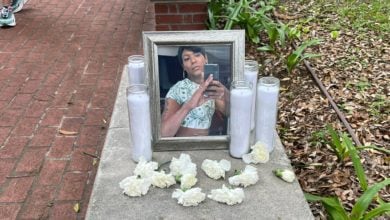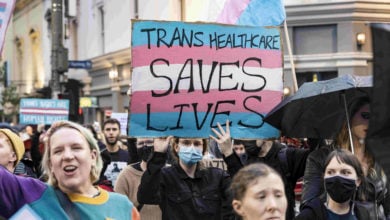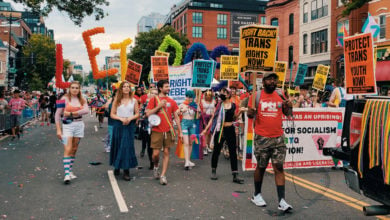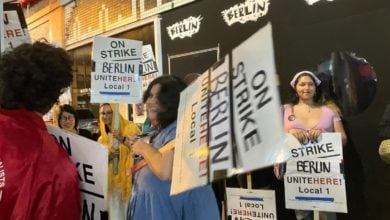Proposition 8, an anti same-sex marriage referendum, was passed by California voters on Nov. 4. But the right-wing bigots who funded the reactionary campaign never thought their sweet victory would turn sour so quickly.
|
This is the first time a state that had granted same-sex marriage rights had those rights potentially overturned. The vote was close, with 52.5 percent approving the ban and 47.5 percent voting against.
Despite the fact that the proposition was approved, the close margin was a victory given that a similar measure, Prop 22, passed with a “yes” vote of 61 percent in 2000. Proposition 22 became the Defense of Marriage Act, defining marriage in California as a union between one man and one woman. Five million people voting “no” on Proposition 8 indicates a strong shift in public perception over marriage equality.
Though the vote was an electoral setback, it sparked an immediate response from the LGBT community. Mass demonstrations developed throughout the state of California and quickly spread across the nation.
In San Francisco, Calif., the first demonstration was on the evening of Nov. 5 at the steps of City Hall. Thousands of demonstrators took part in this action. Several local and a few state-level officials attended the event and urged the protesters to allow the system to run its course with the promise that Proposition 8 would eventually be overturned in the state’s Supreme Court, where appeals have already been filed.
There was little militancy advocated by the officials attending the event. The crowd, on the other hand, chanted for militant action and demanded, “enough is enough,” insisting that now is the time to act.
On the same day, protests also developed in Los Angeles, Long Beach, San Diego and several other cities throughout the state. Protests in Los Angeles had a militant tone from the beginning, and street actions have taken place daily in various neighborhoods, at times reaching 20,000 or more participants.
As the week after the election progressed, the movement continued gaining steam. The evening of Friday, Nov. 7, as many as 25,000 people marched through the streets of San Francisco. The militant protest passed through the heart of the city and into the Castro district, a primarily LGBT neighborhood considered by some to be the LGBT capital of the United States.
After rallying at Dolores Park, the protesters moved back through the streets to City Hall, stopping traffic in an act of civil disobedience. Following a third rally, the protesters again took to the street marching back to Castro. Upon arriving in the Castro, a sit-in was staged at the busy intersection at 18th St. and Castro St., lasting until 5 a.m.
Direct action participants vowed to keep the energy going by committing to plan additional actions. Many of the San Francisco protests have been organized on a spontaneous and grassroots level. Word of the protests spread through the community via text messages, social networking websites and emails.
In a show of solidarity, activists in Salt Lake City, Utah, rallied in Temple Square, the heart of the Mormon Church. The Mormon Church pleaded to its members to give time and donate to the “Yes on 8” campaign, and reportedly funded up to 70 percent of “Yes on 8” expenses. Similar protests have taken place at the Mormon temples in Los Angeles and Oakland, with at least 3,000 activists taking part in each action.
Pitting workers against each other
The media has used racist propaganda to divide workers by blaming the large turnout of African American and Latino voters in the general election. This is a spurious and bigoted argument. In California, African Americans and Latinos comprise 6 percent and 15 percent of registered voters, respectively. It is certain that many people in each of these communities voted for LGBT equality.
This divisive tactic has been used time and again to fracture the movement. It is imperative that revolutionary and progressive activists reject any notion that oppressed people are to blame for the passage of this proposition. Only through solidarity does any civil rights movement stand a chance of defeating the ruling-class agenda of marginalization of oppressed peoples.
In addition, the “No on 8” forces were drastically outspent by the anti-gay “Yes” forces. The “Yes on 8” campaign was strongly supported by several right-wing conservative organizations, including religious institutions such the Mormon Church, the Catholic Church and Orthodox Jewish organizations. By the time the poll numbers started to shift significantly, the “No on 8” campaign was off guard and unprepared.
The tactics of the “Yes” campaign rested on misinformation and outright lies. Their commercials amounted to fear-mongering, stating that young children—including pre-schoolers—would be subjected to same-sex education.
This was a lie. California law states that no child can be subjected to any sex education classes without express permission from his or her parents, with the class curriculum made available to the parent beforehand. As a matter of fact, the curriculum would not have changed at all from the current format that is already offered within the school system.
Another commercial depicted a class of first-graders attending their teacher’s same-sex marriage during a field trip. This outing was not a school-endorsed event; rather, a parent arranged for the children to attend the wedding and any of the children involved went only with the express permission of their guardians.
It was this direct appeal to the most backward and bigoted views of homosexuality that was used to shift opinions of many undecided voters and to reinforce institutional discrimination. Many activists involved in the struggle for equality have expressed grave concern that religious institutions would be a party to such homophobic and deceptive ad campaigns.
The ballot or the streets?
Much of the “No on 8” campaign was rooted in the Democratic Party machine. Organizers fighting the measure chose not to mobilize the hundreds of thousands of LGBT community members and supporters or build on the growing support for inclusion and equality.
Instead, the approach was to use well-known personalities to appeal to the electorate and to frame the issue as one of fairness, not of LGBT rights. Dianne Feinstein, a former mayor of San Francisco and currently a U.S. senator from California, starred in a “No on 8” commercial and never once mentioned that the proposition or the struggle was about LGBT equality.
The 1969 Stonewall Rebellion in New York City marked the beginning of the modern LGBT movement. Since that fateful day in June, militant struggles by millions of LGBT people and supporters have resulted in many advances toward equal rights, including inroads into the political process. As a consequence, many LGBT organizations have formed an alliance with the Democratic Party.
The leadership of the Democratic Party did not want issues such as same-sex marriage or LGBT rights to be in the spotlight in an election year. Thus many LGBT organizations cautioned that any militant struggle around same-sex marriage rights could possibly became a national issue and lose the presidential election for Barack Obama. While a number of LGBT organizations latched onto this false argument and mobilized for Obama, the LGBT community was muted.
In the months leading up to Nov. 4, Proposition 8 was losing in the polls by double digits. It is fair to say that many believed that the proposition had no chance of passing. The effort to defeat Proposition 8 was primarily limited to phone banking a narrow sector of the voting public believed to be undecided.
But the passage of Proposition 8 seems to have shifted the struggle for equality from electoral tactics toward militancy and mobilization. For a long time, the LGBT liberation fight has often been limited to lobbying organizations and progressive think tanks that discouraged and, at times, held back militant struggle.
The passage of Proposition 8 has effectively angered millions of people and prompted a massive mobilization of the LGBT community and progressive people across the country. Should the LGBT liberation movement stay this new course, there will be an opportunity to connect the issues of workers oppression with that of the liberation of all oppressed communities. A new civil rights movement may be here.






